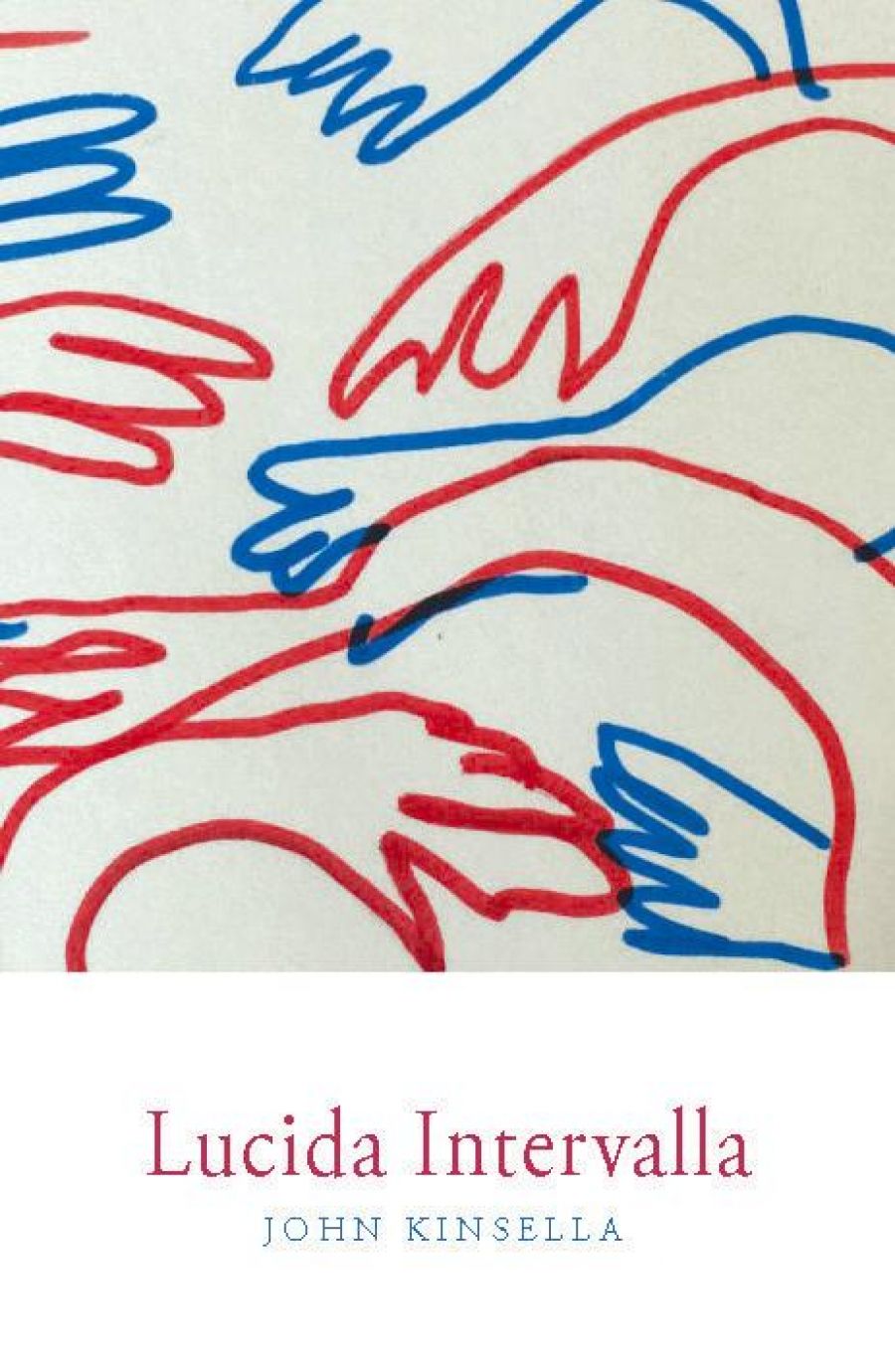
- Free Article: No
- Contents Category: Fiction
- Custom Article Title: Francesca Sasnaitis reviews <em>Lucida Intervalla</em> by John Kinsella
- Review Article: Yes
- Online Only: No
- Custom Highlight Text:
According to the online resource Climate Action Tracker, Australia’s emissions from fossil fuels and industry continue to rise and are heading for an increase of nine per cent above 2005 levels by 2030, rather than the fifteen to seventeen per cent decrease in ...
- Book 1 Title: Lucida Intervalla
- Book 1 Biblio: UWA Publishing, $24.99 pb, 240 pp, 9781760800079
Fundamentally, Lucida Intervalla – disjunctive and impressionistic in structure, admittedly ‘composed over many years’ – sees the author at play with words; in thrall to language and ideas. Kinsella credits the life and writings of philosopher Søren Kierkegaard for inspiring the distortions, digressions, narrative manipulations, and pyrotechnic excesses of literary and artistic allusion in which he revels.
As for the anti-heroine of this, his third novel, Lucida Intervalla appears to be the apotheosis of everything Kinsella detests. Self-serving and superficial, she is without moral compass. In her greed for fame, experience, power, and money at the expense of everything around her, she is the poster girl for post-feminist despotism, amusing at first but horrifying in retrospect. She is an exasperating figment of her creator’s imagination, his alter ego and his nemesis. And yet Kinsella endows this egomaniacal character with pathos, a backstory that explains, though does not excuse, the development of his digital-age Machiavelli.
 John Kinsella (photograph via Fremantle Press)
John Kinsella (photograph via Fremantle Press)
Lucida is a slippery character. Her name means ‘lucid moment’ in Latin and refers to periods of temporary sanity between bouts of madness. It cannot be a coincidence that her name is also the title of a collection of doggerel verse written in 1679 by James Carkesse, the inmate of an insane asylum. Both heartless and hurt, Lucida has translated herself from a misunderstood and neglected child into an arch media manipulator and artist, an interpreter and appropriator of other artists’ work.
In Kinsella’s game, Lucida is both the star of the show and the audience of her own celebrity. Will the real Lucida Intervalla please stand up? Kinsella matches aspects of her personality to typefaces from a font group that includes Lucida Bright, Lucida Blackletter (a gothic script), and Lucida Sans. It’s a pity the publication doesn’t make use of the various font styles. Perhaps that would have been overkill in an already overabundant text.
The artist known as Duke is Lucida’s primary source before he disappears, and she is accused of his murder. He is as evasive as Lucida, ‘searching for what he calls the “ineffable”’. Descriptions of his art recall, in turn, a feral John Wolseley wielding charcoal from his own campfire, exponents of the CoBrA style, a poor imitation of Robert Smithson, conventional landscape artists, and the best of Sidney Nolan. He appears as an iteration of Kierkegaard transplanted to an antipodean landscape. There are references to a Victor Emerita (Latin for ‘victorious hermit’), the pseudonymous editor of Either/Or, and to a Climacus, the pseudonymous author of De omnibus dubitandum est (everything must be doubted), a title Kinsella surely intended as a sign that everything is open to interpretation. And not forgetting the original Saint John Climacus, the sixthor seventh-century monk whose Ladder of Divine Ascent is obliquely referenced in a joke Lucida makes about her laddered stocking not being the pathway to Paradise. Climacus is also credited with the ascetic practice of carrying a small notebook in which to record one’s thoughts, a habit I imagine Kinsella adopted long ago.
Duke does complain of being ‘tired of translation’. Before the Danes adopted him, he was a simple ‘sou’-west coast and forest boy from the tall timbers and hippy commune milieu’ of a place called Denmark. At some point in his sketchy past, someone must have mistaken the Western Australian town for the nation state and allowed the Danes to claim him in perpetuity. Perhaps his disappearance can be explained by a desire to return to the anonymity of his youth, pre-Lucida and her mistranslations of his life.
It is not a spoiler to reveal that the novel ends with the hilarious image of a deified Lucida reading Aristophanes’s satire The Clouds to her parrots. That Kinsella does not provide a translation from the ancient Greek hardly matters. The clue to deciphering Lucida Intervalla lies in the conclusion of the play, a wanton act of destruction that sees reason symbolically reduced to ashes, and that can be read as a warning from Kinsella of the imminent apocalypse.
Lucida Intervalla is a cryptic vision of the future and undeniably dependent on the references each reader brings. It could mean the difference between plunging into a purgatory of impenetrable allusion or delighting in the dizzying heights of infinite interconnectedness. In either case, the reader will be left gobsmacked by what is Kinsella’s most extravagant, experimental achievement to date.


Comments powered by CComment